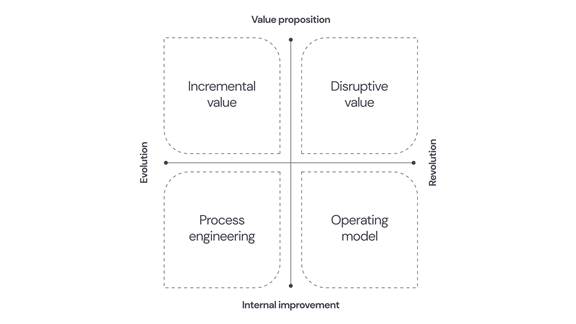Finding the best fit
One key consideration is to identify the constraints that the business is currently facing. For organisations struggling to grow their sales, the priority will likely be external improvements – innovation to deliver the products and services that will secure this growth. By contrast, for those struggling to meet existing levels of demand, or to do so profitably, internal improvement is probably the priority, with innovation that improves productivity.
“The harder decision is how big you really want to go,” adds Schanfield. “One factor is certainly risk, particularly in economic uncertainty, when incremental change may feel more prudent; but you also need to look at the competitive environment. Has the rest of the market already reached where you're heading for? If so, you may need to jump to a greater level of change.”
Broadbent makes the point that it is possible to pursue different types of innovation at the same time, even if one quadrant or another takes priority at different times.
“We have a continuous improvement strand to our innovation because we think incremental change, when aggregated, can help us start to transform the bank; that’s probably the area you dial up in times of economic challenge,” he says. “We also have a disruptive strand, which asks those big questions about the future – and maybe we rein that in a little during a downturn.”
Equally, Marc Hernandez Estrada, director of digital product at Spanish retailer Mango, points out that even in a downturn, there will be opportunities to go big. He joined Mango recently, having previously helped to found Youtility, a technology platform for the banking sector, right in the middle of the Covid-19 crisis.
“When other companies are being careful, it can be a good time to make leaps ahead,” he says. “By the time the recovery comes, you may have secured a crucial advantage.”
Innovation in practice
The right approach to innovation will vary from one organisation to the next – but there will be a right approach, and it won’t be just to give up on innovation until the economic storm clouds pass. “Your innovation strategy should be to map all the things you wish you could change to the quadrants, and then decide where it makes sense to focus,” adds Schanfield. “Then you have to figure out how to bring those initiatives to life, and how much to invest.”
The latter imperative is a question of resources – how to put the organisation’s assets to work to support its innovation initiatives, as well as whether it currently has all the resources it needs. Potential resources to draw upon will include financing, the intellectual capital of your people and the value of your brand. But increasingly, the most important resource of all for innovation is data, argues Kin + Carta’s Kainth.
If an organisation’s data is integrated, trustworthy and widely accessible – none of which is straightforward to achieve – it can provide much-needed directional guidance for innovation initiatives.
“Your data provides a single source of the truth so that you can really understand what bets you should be making and how to make them,” Kainth says. “It provides the foundational groundwork to help you make smarter decisions and to break the cycle of uncertainty and risk that can give innovation a bad rep.”
Innovation, after all, always depends on a hypothesis. Product development executives might propose an improvement or addition to the existing range because they think this will drive increased sales. Operations teams suggest an area where change is most likely to deliver efficiency gains. The breadth of data that is available today, and the sophistication of the tools to analyse it, mean improvements can be tested in advance – and tweaked over time according to what post-innovation data reveals about results on the ground.
“The insight I get from our data team that makes me sit on the edge of my chair is what customers do as well as what they say,” adds RBS International’s Broadbent. “We have the capability to see a customer’s journey in the way they’ve experienced it – their behaviour gives you a picture of how to improve.”
To get to that point, many organisations will need to improve their current data collection, management and analysis systems. But the important thing, Kainth insists, is to focus on what you need to know in order to deliver innovation with greater precision.
“Data represents an opportunity to de-risk innovation bets by testing hypotheses with greater rigour.”
“Data is often seen as something quite mystical and impossible to ever truly understand,” she says. “But the key is to simply start thinking about the business questions that you want to be able to answer more reliably – the ones where knowing the answers will really help you to make money or save money, to drive growth or cut waste.”
Seen through that lens, the data imperative becomes less intimidating. It represents an opportunity to de-risk the innovation bets that organisations make by testing hypotheses with greater rigour in advance and being able to iterate more intelligently later on.
That’s valuable at all times, but in a highly uncertain environment, the ability to de-risk looks even more attractive. It may even give the organisation enough reassurance to put its risk aversion to one side in order to embrace innovation even in a climate of uncertainty and volatility.
Upshot
■ Double down on innovation – even if the business outlook feels threatening, this is an opportunity to jump ahead of timid competitors.
■ Choose the innovations of best fit – innovation doesn’t have to mean a major change every time. Identify which types of innovation are right for your business right now.
■ Marshal your resources to drive innovation execution – maximise your chances of success by giving innovation the resources it needs; in particular, data provides the insight you need at each stage of the innovation process.





